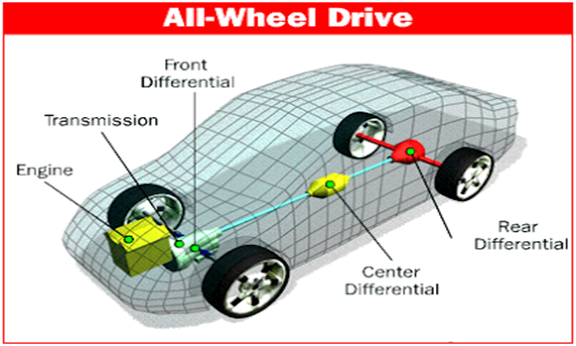Image source: mechanicalmania.blogspot.com
All-wheel drive vehicles operate on full-time four-wheel drive system with high-performance and heavy-duty vehicles. The vehicles have a front and rear differential between each set of the drive wheels and at the center of both wheels. A computer technology which determines how much power is distributed to each wheel.
Pros:
1. Extra traction and towing: AWD increases the traction of the vehicle by allowing the four wheels to spin to ensure the vehicle withstand any weather condition. The wheels improve traction and no more worries when on slippery or snowy areas.
2. More efficiency: Regardless of where you stay, the AWD gives you a piece of mind since it can fully function in tough terrains like snow, heavy rains among others.
3. Resale value: The resale value of AWD is much higher than the 2WD. This is due to the up-front costs and the capability of the vehicle.
4. No getting stuck: If one of the wheels is stuck in the mud, the power is distributed to the other wheels increasing traction. Once you press on the acceleration, the stuck wheel doesn’t go deeper into the mud.
5. Collision avoidance: Due to the vehicles increased weight, they are more effective and have superior collision avoidance compared to other light vehicles.
6. Weight: Due to its additional weight, the AWD contributes to better grip when moving in icy and rocky roads.
7. Off-roading: If you like off-roading, then you will definitely love AWD vehicle. It is useful if in area than experience long winters and harsh seasons.
8. Faster acceleration: If you’re on a normal road, you easily achieve faster acceleration and convenient turning of the vehicles thus making the steering pretty smooth.
9. Easy to drive: Due to its weight, it is easy to drive at faster speeds without compromising the vehicle security or losing control especially on a tough terrain.
10. Improved dry handling: AWD with torque vectoring technique uses electromagnetic clutches to distribute torque in the rear wheels of the vehicle.
Cons:
1. Cost: It is very expensive to buy AWD compared to 2WD and it is also very expensive to maintain this type of vehicle. They also have a higher resale value of a used all-wheel drivetrain.
2. Gas mileage: AWD cars have the worst fuel economy than the 2-wheel vehicle. More energy is needed to deliver power to the 4 wheels. This increases the fuel consumption of the vehicles.
3. Weight: Four-wheel drive vehicles are very heavy affecting the fuel economy of the vehicles. This makes them less efficient than the 2WD.
4. Maintenance cost: The cost of regular maintenance of the vehicle is very high. The cost of repairs is also very high.
5. Breaking distance: The increased weight not only add traction and handling of the vehicle but also increase the braking distance.
AWD vehicles have high breaking distance making them take long before they come to a stop. In case of light vehicles, they can cause a collision.
6. Transmission: The AWD transmission is affected by the level of tear and wears on each tire. If one tire burst, you need to replace all the four tires.
7. Uniform tire tread: All the four wheels of your vehicle need uniform tire tread depth and wear otherwise it will affect the wheel balancing and rotation of the vehicles.
8. Complex components: AWD system require more tools and also have complex transmission components compared to other 2WD design wheels.
9. Powertrain mass: AWD systems increase the drivetrain mass, rotational inertia, and the power transmission loss. This results in reduced performance and increase in the fuel consumption.
10. Handbrake problem: The handbrake cannot be used to induce oversteer. In a sports car, a custom-made mechanism is added to the vehicle to disconnect the rear drive wheels in case the handbrake is used on a moving vehicle.



